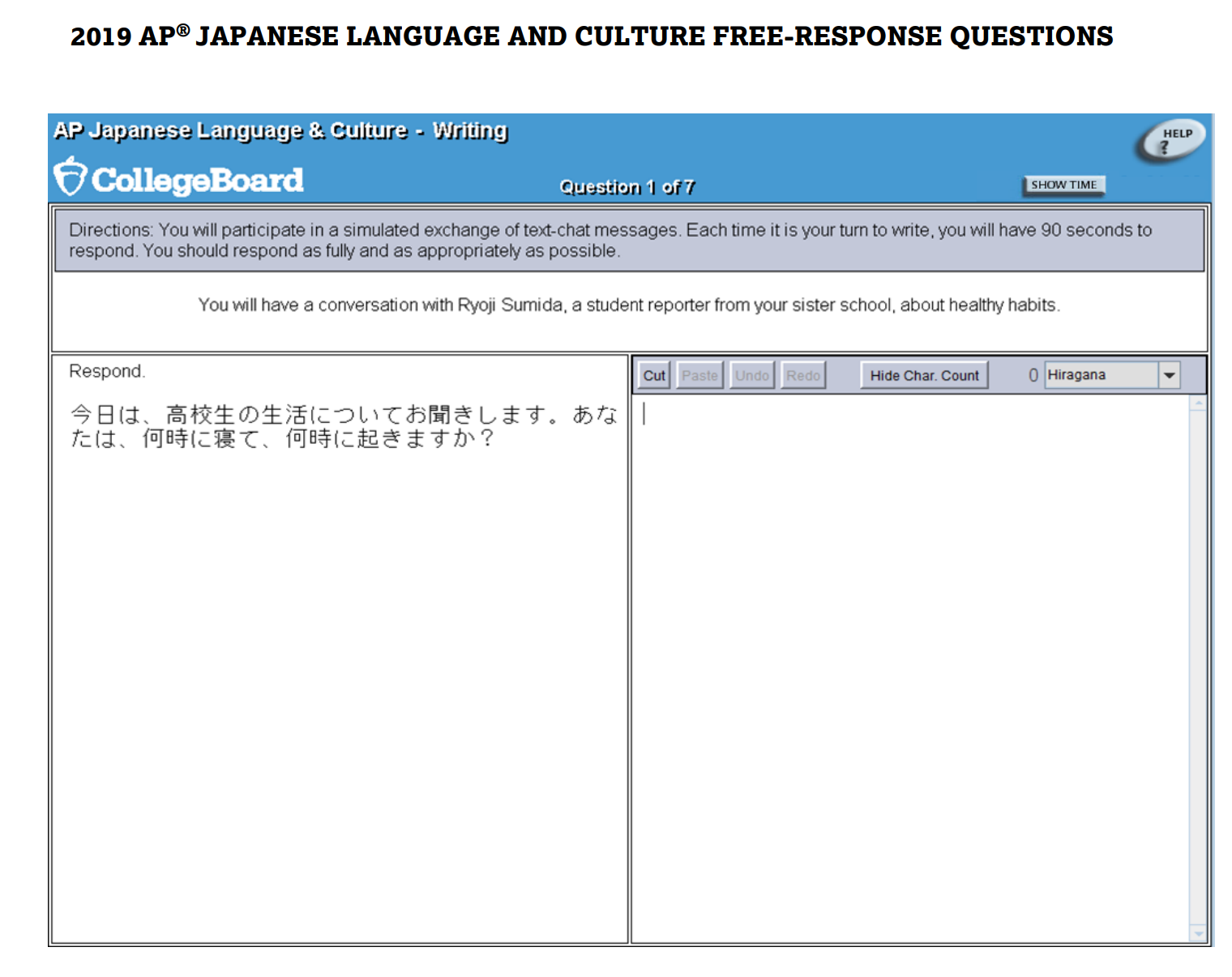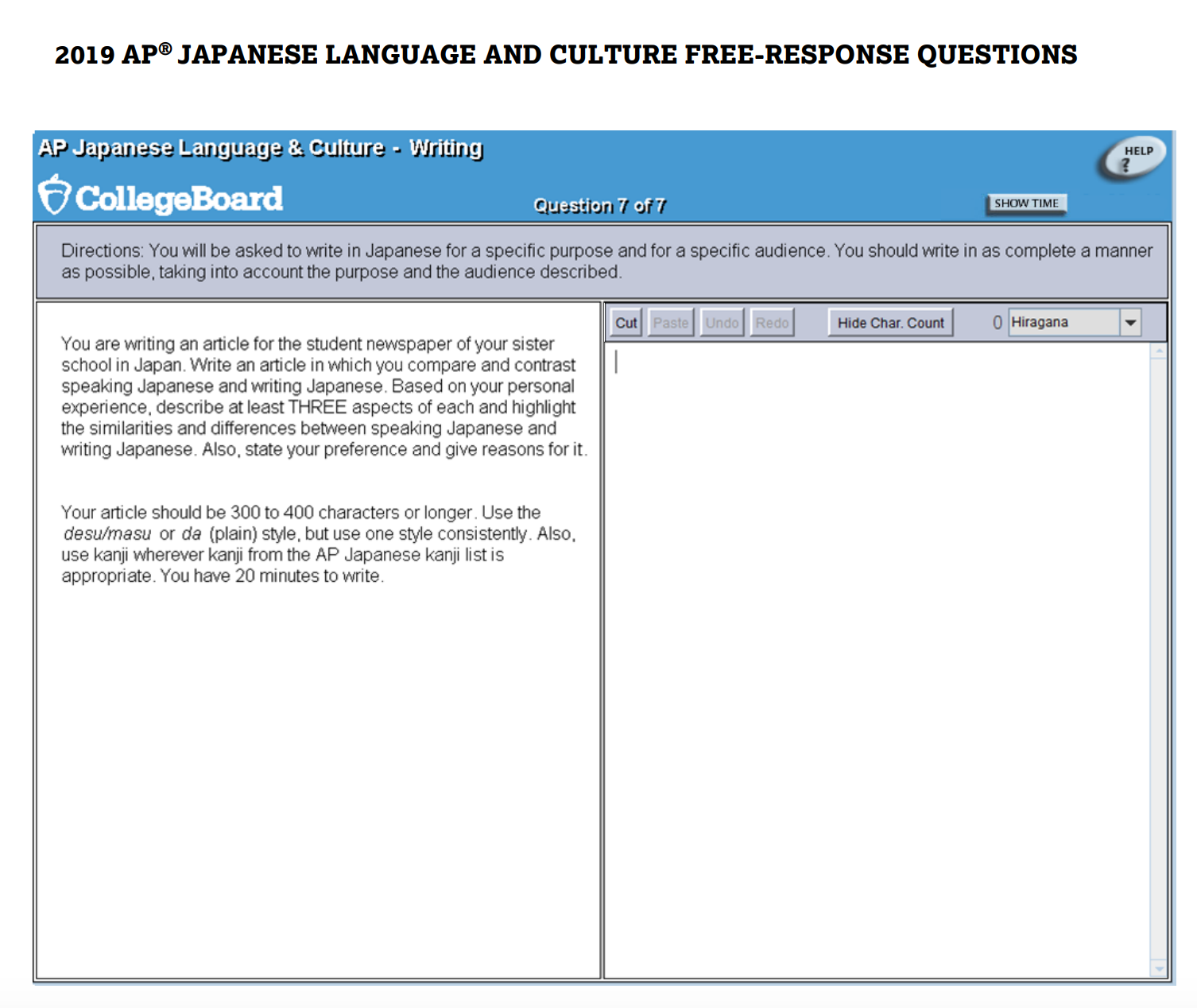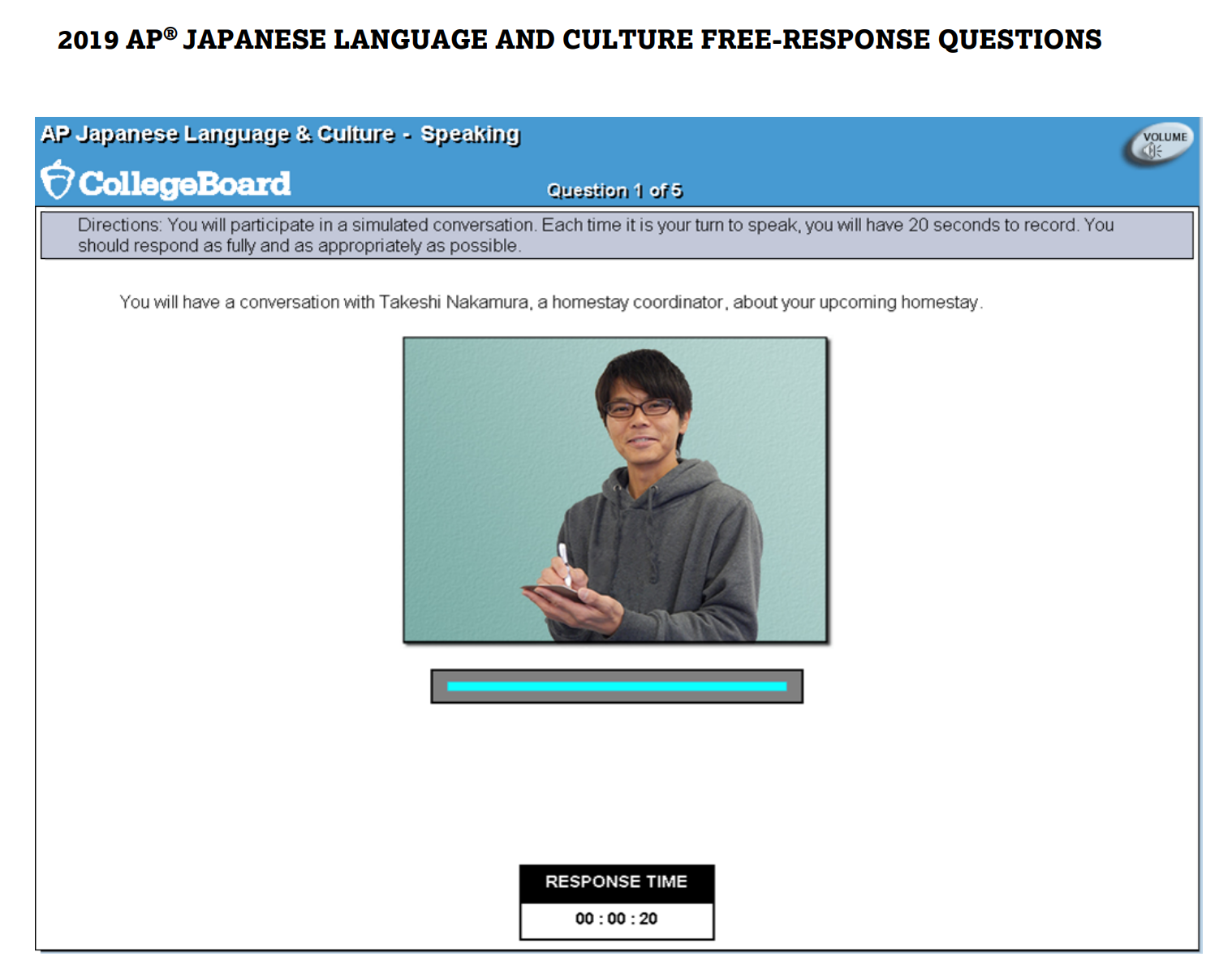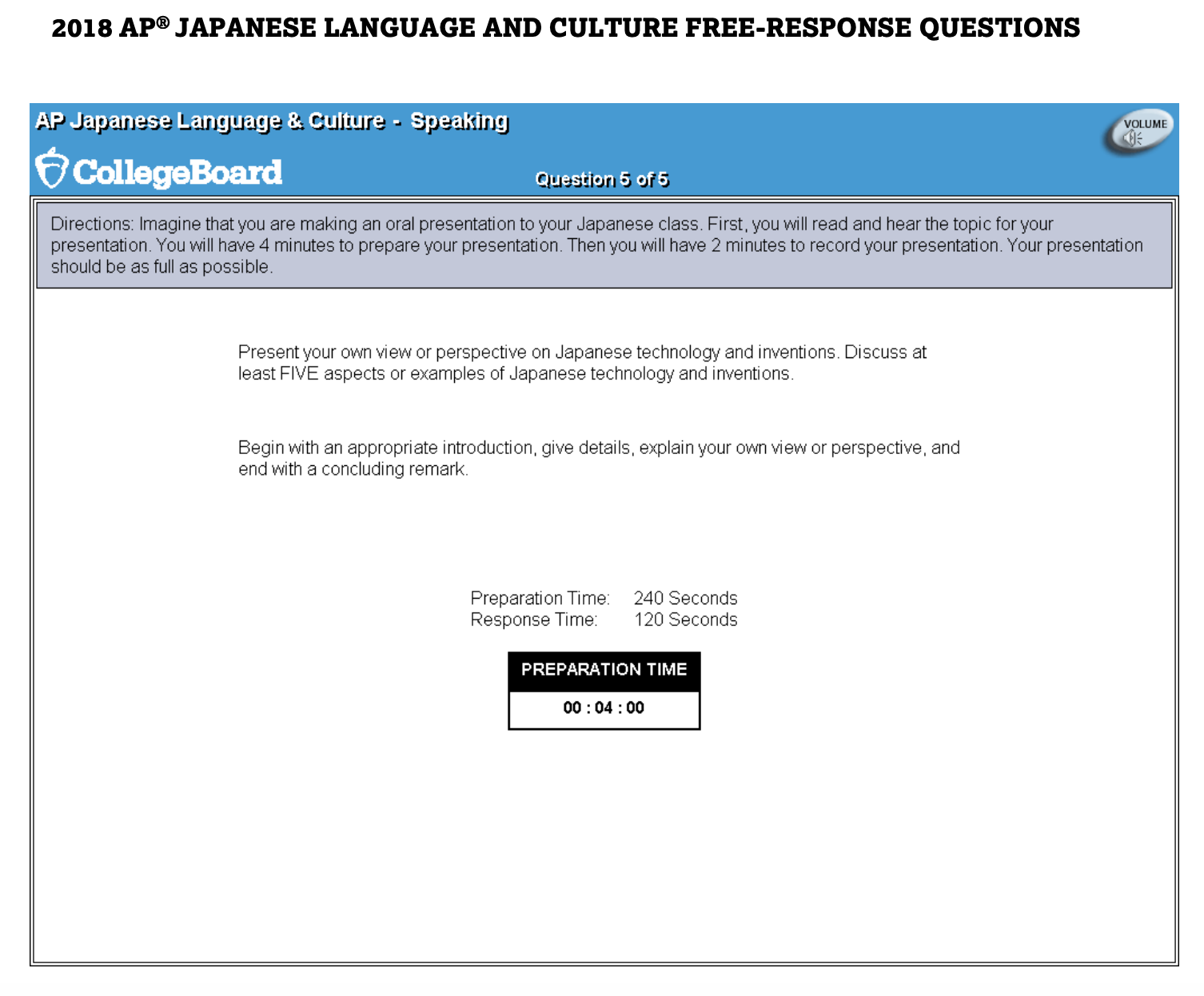AP Japanese Exam Guide
6 min read•november 16, 2020
Katelyn Lien
AP Japanese 🇯🇵
28 resourcesSee Units
If you are looking for a comprehensive study guide for the AP Japanese Language and Culture Exam, you have come to the right place! Below is a review of everything you should know before the exam and useful tips that will help you pass the exam.
🔍 If you want an in-depth review of any of the six units, here are the links to each of them:
- Unit 3: Influences of Beauty and Art 🎨 (coming soon)
- Unit 4: How Science and Technology Affect our Lives 🔬 (coming soon)
- Unit 5: Factors that Impact the Quality of Life 🏠 (coming soon)
- Unit 6: Environmental, Political, and Societal Challenges 🌪 (coming soon)
✔️ Scoring
Doing well on AP tests are helpful for a number of reasons. For example, you could earn college credit while still in high school which would allow you to skip some lower-level college classes.
AP exams are scored on a scale from 1 to 5. (5 is the highest and 1 is the lowest possible score)
The College Board defines their grading scale as:
- 5️⃣ = Extremely well qualified
- 4️⃣ = Well qualified
- 3️⃣ = Qualified
- 2️⃣ = Possibly qualified
- 1️⃣ = No recommendation
While a score of 3 is a "passing grade," most colleges will only give credit to scores of 4s and 5s. Try to aim for a 4 or 5 but even if you earn a 3, don't worry! It will show colleges that you are ready to take college-level courses.
Some colleges do give credit for a 3 so make sure to check their website for the most accurate information.
💫 Course Skills
The six suggested course themes by the College Board are 👪 Families and Communities,😇 Personal and Public Identities,💄 Beauty and Aesthetics, 🧪 Science and Technology, 🎋 Contemporary Life, and 🚧 Global Challenges. Along with assessing themes from all six units of the course, the exam also assesses a set of skills that should be developed throughout your studies.
The College Board lists a total of 8 skill categories:
- Comprehend text (文章を理解する)
- Make connections (相互理解する)
- Interpret text (文章を訳す)
- Make meanings (意味が通じる表現を使う)
- Speak to others (人に話す)
- Write to others (相手に書く)
- Present orally (口頭で発表する)
- Present in writing (文章で説明する)
📄 Exam Format: AP Japanese
💻 The AP Japanese Language and Culture Exam is administered entirely on the computer and is 2 hours and 15 minutes in length.
The exam contains two sections and you will:
- Read on a computer screen
- Type on a keyboard
- Using Microsoft IME (required)
- Listen through headphones
- Speak into a microphone
Section 1A: Multiple Choice Listening 🎧
- 30-35 questions, 20 minutes, 25% of score
- You will listen to a variety of audio clips
Helpful Tip: Take notes as you listen! You will not be able to preview the multiple-choice questions before listening to the audio so write down your notes on the provided scrap paper (Scrap paper is not graded).
- Multiple choice questions are written in English
- 12 seconds to answer each question, you may NOT move between different questions
Section 1B: Multiple Choice Reading 📖
- 30-40 questions, 60 minutes, 25% of score
- You will read a variety of short passages
- Must be able to read all 410 kanji from the AP Kanji List
- Multiple choice questions are written in English
🛎️ Multiple Choice Tips and Tricks
The multiple choice section can be difficult, as you will most likely encounter words that you have never seen before or do not know the meaning of. However, with these tricks, you will crush this section like a BOSS 😎.
Before the exam:
- Throughout the entire year, make sure to immerse yourself in the Japanese language
- 📚 Read Japanese books, 🎬 watch Japanese movies, 🎶 listen to Japanese songs
- Participate in class and ask questions
During the exam:
- Use process of elimination 🚫
- At least two options will be completely incorrect
- If you still do not know after narrowing down your options, guess! (You will not get penalized for incorrect answers)
- Use context
- Use the words that you DO know to your advantage
- These words will help you get a sense of what the unknown word means
- Trust yourself
- If you are stuck between two options, go with your gut instinct 👊
- You have studied hard and know more than you might think! 🧠
⏱️ After a 10 minute break, you will begin the second part of the exam.
Section 2
Section 2A: Free Response Written 👨💻 👩💻
- 2 tasks, 30 minutes total, 25% of score
Interpersonal Writing
- Read and answer text messages
- 6 prompts, 10 minutes
- Prompts are given one at a time and you have 90 seconds to type each response
Here is an image of what the text messages will look like:

2019 AP Japanese Free Response Question, Image from College Board
This is the first of six total messages. A sample response to this message could be:
こんにちは、すみださん。私はだいたい10時半に寝て6時半に起きます。学校の宿題がたくさんある時はもっと遅く寝る事があります。
Helpful Tip: Type quickly but make sure to always select the correct kanji when converting from hiragana.
Presentational Writing
- Write a compare and contrast article
- 1 prompt, 20 minutes
- 300-400 characters or longer
Helpful Tip: Write an outline before writing your article.
Sample Outline:
- Introduction
- Three similarities/differences
- Own preference and reason(s)
Example Compare and Contrast Article

2019 AP Japanese Free Response Question, Image from College Board
Response:
これから日本語を書くことと話すことを比べます。違うところも似ているところもあります。
まず、日本語を話す時は漢字を知らなくても大丈夫です。漢字を知らなくても言葉を知っていれば人と会話ができます。日本語を書く時は漢字を知らないと文章が全部ひらがなになってしまう恐れがあります。
次に、日本語を話す時は話す相手によって言葉の種類を変えます。自分より年上の人や偉い人と話す時は「はい」とか「そうです」と言う丁寧な言葉や「いらっしゃる」など敬語を使います。日本語を書く時は文章の形態によって使う言葉を変えます。
最後に、日本語を話す時はあまり考えている暇はありません。言葉が分からなくて長い間考えていると会話が進みません。これと違って日本語を書く時はもっと考える時間があります。すぐに言葉が頭に浮かばなくても、少し考えれば思い出せるかもしれません。
結論として私は日本語を話す方が好きです。日本語で人と話すと嬉しくなり、英語以外の言語で話せると言う自信がつきます。いつか日本に行って実際に日本人と日本語で話をしてみたいです。
Section 2B: Free Response Spoken
2 tasks, 10 minutes total, 25% of score
Interpersonal Speaking
- Participate in a stimulated interpersonal conversation
- 4 prompts, 3 minutes
- After each prompt, you have 20 seconds to respond
Example:

2019 AP Japanese Free Response Question, Image from College Board
Helpful Tip: Make sure you are aware of the person you are responding to and use the proper speech style.
Presentational Speaking
(prep 4 min, 2 min presentation)
- Deliver a 2 minute Japanese cultural presentation
- 1 prompt, 4 minutes to prepare
Helpful Tip: Write an outline during your given preparation time.
Sample Outline:
- Introduction
- Five aspects/examples
- Own perspective
- Conclusion
Example Cultural Presentation

2018 AP Japanese Free Response Question, Image from College Board
Response (spoken)
初めまして私は______と申します。これから日本の技術について話します。
まずは新幹線です。日本の新幹線は他の電車より速いのが特徴です。新幹線は日本中を高速で走っていますから遠い場所でも短い時間で行けます。
次はモノレールです。モノレールは新幹線と違って上からぶる下がって走ります。モノレールは新幹線より遅いです。
三つ目は日本の自動車です。日本の有名な自動車会社は豊田や日産です。日本の車は丈夫で安いので他の国でも人気があります。一年に何台もの自動車を他の国に輸出します。日本の車のハイブリッド技術は他の国に比べて優れています。
最後は日本の炊飯器です。日本人はお米を主食としているので炊飯器は食事を作るために欠かせない道具です。最近はお米だけでなく、ケーキやホットケーキも作れる事がわかってきました。
私は日本の技術発展はすごいと思います。日本人は常に技術革新を目指して研究していることがよく伝わってきます。日本に行く事があれば新幹線に乗りたいと思います。
まとめに、日本の技術はかなり発達しています。新幹線の技術は世界トップレベルで、ハイブリッドの車は日本が一番に作り始めました。将来日本がどのような優れた技術を使って新しいものを作るのか楽しみです。ご清聴ありがとうございました。
🎉 Congratulations, you're done!!
💥 Helpful Transition Vocabulary Words
First:
- まず
- 最初に
- 一つ目
Next:
- 次に
- 二つ目
Also:
- それから
- また
But:
- でも
- だが
- しかし
- けれども
For example:
- 例えば
Comparative words:
- AはBに比べて: compared to B, A...
- AはBと違って: unlike B, A...
- Aの方がBより: A is more ... than B
- AはBほど: A is not as ... as B
Concluding words:
- 最後に
- 結論として
- 以上
The best way to prepare for the exam is PRACTICE! A great study tool is College Board's AP Japanese website of all past exams. There you can look at all of the prompts from previous years and practice answering them on your own. ⌛ Make sure to time yourself, so you know exactly what to expect on exam day.
Get comfortable with the instructions for the prompts. They will generally stay the same each year, so if you are familiar with them, you won't have to waste time reading them during the exam.
You can never know enough vocab words. A great way to increase your knowledge of the Japanese language is to learn just one new word a day. There are so many Quizlet decks of useful vocab words.
🤓Read: AP Japanese - Best Quizlet Decks
Lastly, be confident! On exam day, make sure to speak confidently into the microphone. Even if you make little mistakes, it's okay! You have studied hard and all your work will pay off. 🎊 ✨
Browse Study Guides By Unit
👨👩👧Unit 1 – Families in Japan
🗣Unit 2 – Language & Culture in Japan
🎨Unit 3 – Beauty & Art in Japan
🔬Unit 4 – Science & Technology in Japan
🏠Unit 5 – Quality of Life in Japan
💸Unit 6 – Challenges in Japan
✍️Exam Skills - FRQ/MCQ
AP Japanese Exam Guide
- ✔️ Scoring
- 💫 Course Skills
- 📄 Exam Format: AP Japanese
- Section 1A: Multiple Choice Listening 🎧
- Section 1B: Multiple Choice Reading 📖
- 🛎️ Multiple Choice Tips and Tricks
- Section 2
- Section 2A: Free Response Written 👨💻 👩💻
- Example Compare and Contrast Article
- Section 2B: Free Response Spoken
- Example Cultural Presentation

Fiveable
Resources
© 2023 Fiveable Inc. All rights reserved.